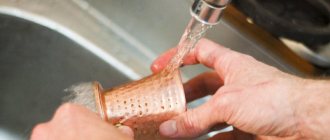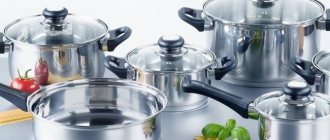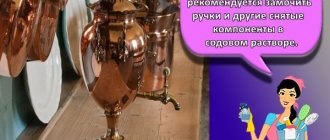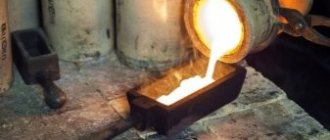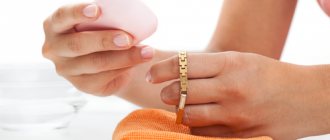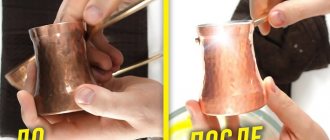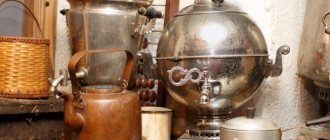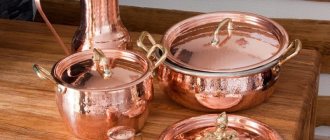People have been making bronze products for a long time. They are used to decorate the interior, create a themed setting, and an antique effect. However, without proper care, over time the surface of this metal begins to fade. In order for products to retain their original appearance for a long time, you need to know how to clean bronze.
Cleaning bronze at home
Why does plaque appear?
A freshly cast or processed bronze product is characterized by a dark yellow color. Over time, its surface begins to fade and darken, reaching a black color. Plaque occurs due to the interaction of the metal surface with air or liquid.
The air contains active substances such as oxygen, hydrogen sulfide, carbon dioxide, water vapor, and other liquids in a vapor state. The molecules of these substances react with molecules of copper and tin, forming oxides and salts. The oxide layer, consisting of copper oxide, is called black or noble patina. This surface film protects the bulk of the metal from oxidation and corrosion. Usually they don’t fight black patina, believing that darkened objects look more ancient, noble and elegant.
Plaque on bronze
There is also another type of patina - a green coating. It is also called "wild". Such stains and deposits appear due to the effect of water vapor molecules on the metal. Plaque does not cover the object with a protective layer, but destroys it, penetrating deeper and deeper into the metal layer. The surface is subject to erosion, the emerging depressions grow and turn into depressions. To prevent damage to the item, it must be cleaned using one of the many known methods at home or in a workshop.
Plaque on bronze and means to combat it
Over thousands of years of using bronze objects and parts, people have tried many ways to clean bronze. Both compositions of mineral origin, plant origin and even food products were used. Of the dozens of methods, not all are suitable for use at home.
How to clean bronze using affordable means
For this you may find it useful:
- lemon juice;
- baking soda (chemical name: sodium bicarbonate);
- plain flour;
- vinegar 9% (not to be confused with vinegar essence);
- ammonia (10% aqueous solution, purchased at a pharmacy);
- aqueous solution of oxalic acid;
- finely ground chicory;
- aqueous solution of sulfuric acid;
- school chalk;
- wood sawdust.
To work you will need:
- cotton rags;
- cloth;
- wipes for drying the surface;
- stainless steel container for mixing and heating the components of the cleaning composition.
Many compounds used to clean bronze objects are chemically active and can seriously damage the skin or mucous membranes. Therefore, when working it is necessary to use personal protective equipment:
- gloves;
- apron;
- glasses or clear face shield;
- Tight clothing, shoes and hats to prevent contact of active substances with the skin or mucous membranes.
Removing plaque from bronze at home
After cleaning an item using any method, you should rinse it with water to remove any remaining composition and be sure to dry it thoroughly. Wet bronze objects become coated several times faster than dry ones.
Important! It is impossible to clean plaque on bronze once and for all. The treatment will have to be repeated periodically.
How do you usually clean bronze?
Want to make your old candlestick shine again?
Then stock up on the following available means: baking soda and lemon juice, ordinary table salt and vinegar, oxalic acid, ammonia, acetone, chicory powder, sulfuric acid, sawdust and chalk, peas. You don't need to buy absolutely everything listed above. This is a list of substances that are most effective in cleaning bronze.
How to clean a bronze candlestick without the correct equipment and necessary protective equipment? Don’t forget about this nuance; prepare protective gloves, a bowl and napkins. We may also need a cloth rag and wool rags.
Cleaning with Natural Remedies
Since ancient times, people have used improvised means to clean bronze objects from oxidation. Many of these methods are still easy to use today to clean bronze at home.
Chicory powder
Powdered chicory used in cooking can successfully remove patina. It is used like this:
- A tablespoon of chicory is diluted in warm water. Stir until the consistency of thick sour cream.
- Apply the paste to the product and wipe off stains with a soft brush. For small items or relief details, it is convenient to use an old toothbrush. The pressure should be soft.
- Rinse the item with plenty of water and dry thoroughly with napkins.
Cinnamon powder
Peas
The popular legume plant perfectly cleans the bronze surface of dust, soot and other foreign contaminants. The sequence of actions is as follows:
- The products that are going to be cleaned are placed in a container with several spoons of peas.
- The container is filled with water so as to completely cover the bronze objects.
- The water is brought to a boil and simmered over low heat for 2-3 hours.
- The items are transferred to another container and cooled.
- The surface is wiped with a soft brush or cloth to remove any remaining dirt.
The surface should be thoroughly dried.
Methods for cleaning bronze
You can deal with plaque on bronze at home. For cleaning you will need the following substances and tools:
- rubber gloves to protect the skin of the hands;
- soft napkins;
- flannel or suede rags;
- containers of suitable sizes;
- the chosen cleaning agent (chicory, vinegar, table salt, ammonia, soda, etc. - you can use one substance or a combination of several).
Chicory
Chicory will help get rid of minor stains.
- Mix chicory powder with water to obtain a homogeneous paste.
- Apply the mixture to a bronze item or brass coin. Wipe the surface with a soft brush.
- Rinse the item with water and wipe dry.
- Polish the surface to a shine with a piece of suede.
Vinegar, flour and salt
The means at hand that every housewife has in her kitchen - vinegar, table salt, flour - will help remove plaque.
- Rinse the bronze product with running water.
- Mix flour and table salt in equal proportions.
- Add a little vinegar, stir until smooth.
- Apply the mixture to the product and leave for 30 minutes.
- Rinse off the cleaner, dry and buff with a soft cloth.
Lemon juice and soda
The natural acid contained in lemon will help clean bronze items.
- Rinse the surface with running water, removing dust and other visible contaminants.
- Pour 2 tbsp into a container. l. soda, add lemon juice, mix well.
- Apply the resulting mixture to the surface and rub in a circular motion. Use a soft cloth or brush to get into the tightest corners.
- After 20 minutes, rinse the item with running water.
- Wipe the item dry and polish with a piece of soft suede.
Cleaning with household chemicals
If natural remedies do not help, you can use more powerful compounds from the arsenal of household chemicals. The most harmless among them is a specially designed raster for cleaning copper, brass and bronze “Trialon-B”. It is used by numismatists to clean valuable coins. The concentrated product is diluted with water 1:10, the product is lowered into the solution and its surface is carefully monitored. As soon as the plaque has dissolved, the object is immediately removed with tweezers, washed with water and thoroughly wiped dry.
Using Chemicals to Clean Bronze
Bronze cleaning can also be done with the following substances:
- Ammonia, or ammonia. To clean a bronze item, you need to lower it into a container with a solution and after a couple of minutes remove it, rinse and dry it.
- Acetone.
- Oxalic acid.
- Soda Ash. Used for large products for which it is not possible to find a container of sufficient size. Moisten a brush or cloth with an aqueous solution (1:20) and wipe the areas covered with plaque.
After wiping, rinse the surface with plenty of water and dry it thoroughly.
Acetone
To clean bronze items, you can use a strong organic solvent - acetone. A cotton pad is soaked in solvent and rubbed into contaminated areas. When discs become dirty, they should be replaced with clean ones; the more often the better.
Acetone
When working with acetone, it is necessary to have exhaust ventilation - inhaling large amounts of vapor can lead to loss of consciousness and poisoning. Or the treatment must be carried out outdoors. After wiping, the product must be rinsed and dried.
Oxalic acid
A potent chemical is used in advanced cases when it is not possible to clean with other means. You can buy oxalic acid at a pharmacy or chemical store. To clean plaque, you need to:
- Prepare the solution. For 5 liters of cold water, take 100 ml of acid.
- Immerse the items to be cleaned in the solution. They should be completely covered with liquid.
- After the liquid darkens, the products should be removed from the solution.
- Next, you need to rinse them with plenty of water and dry thoroughly.
To enhance the effect of the solution, aluminum sulfate is sometimes added to the acid.
Attention! Concentrated oxalic acid is hazardous to health. The use of personal protective equipment is mandatory. The room should be well ventilated.
Paste GOI
The polishing paste, developed at the State Optical Institute and named after him, is intended for polishing metal and non-metallic surfaces. It contains fine-grained abrasive substances and, if handled carelessly, can destroy the smallest details of the relief. Therefore, it is recommended to use it for objects of simple design that do not have artistic value and fine relief. The paste is prepared independently, the finest corundum powder is mixed with wax or paraffin. Or it can be purchased ready-made in stores.
Sulfuric acid and potassium
Sulfuric acid is an even more potent reagent than oxalic acid. When working with it, special care must be taken. It is used to clean deeply patinated items. The operation sequence is as follows:
- Prepare a glass container of sufficient volume. Metal utensils will not work - sulfuric acid will dissolve them.
- Pour a liter of cold water into it.
- Add 20 grams of potassium dichromate and stir.
- Slowly pour in 20 ml of concentrated sulfuric acid over a glass rod.
Important! You can't pour water into acid! This will cause hazardous chemicals to splash.
- Place the items to be cleaned in an acidic solution.
- Prepare a second container with ammonia.
- After the patina is corroded by acid, carefully remove the bronze objects with tweezers or hooks and soak them in ammonia.
- Rinse with plenty of water and dry thoroughly with paper towels or a soft-lint cotton cloth.
There is no such thing as excessive caution when working with sulfuric acid.
Ammonia
Candelabra, candlesticks, large figurines, and antique watch cases cannot be cleaned with ammonia. However, it will handle small items, coins and medals well. Cleaning proceeds as follows:
- Ammonia is poured into a deep container.
- Place the items to be cleaned in the container so that they are completely covered with liquid.
- Leave for a few minutes to half an hour, observing the state of the patina.
- After achieving the desired effect, the items are removed, washed with plenty of water and dried thoroughly.
To consolidate the cleaning effect, it is recommended to treat the surface with alcohol and paraffin.
When working with ammonia, you should use personal protective equipment, including a respirator. The room must be well ventilated or equipped with exhaust ventilation.
What is brass and where is it used?
Brass is an alloy of copper and zinc. Tin, manganese, lead, nickel, and aluminum can be added to it. The composition affects the color and properties.
Zinc, the main component of brass, was only discovered in the 16th century. At the same time, people knew about it before our era. For example, in Rome they made alloys of copper with zinc ore and created dishes and jewelry.
Then production began in Central Asia, from there the accessories came to Rus', where their unique shine and high quality were also appreciated. After zinc was discovered in 1746, brass appeared in the form familiar to modern times.
The standard formula is the proportion of copper and zinc 1 to 2. Now zinc can be added much less, no more than 30 percent. For technical alloys the percentage increases to 50%. The more zinc there is in a product, the lower its price.
Such alloys are considered one of the most common; they are called eternal metals because they hardly wear out. Two-component types, where zinc is 20 percent, are used for automobile spare parts, coils, and heating equipment. The 40% composition is suitable for stamped products and accessories. Multi-component brasses have a very wide range of applications. They are used to make aircraft, pipes, watches, springs, and ships.
Tombac, which contains up to 10 percent zinc, is used to create artistic accessories and decals. Cages, fittings and bearings are made from cast brass to provide rust resistance. Automatic alloy is used for fasteners.
Resistance to magnetic attraction makes it possible to make compasses, and high heat capacity makes it possible to make samovars. Objects for the church are made from brass, such as the frame of an icon. The cost of the alloy is quite low, and prestigious items such as the famous Zippo lighters are made from it.
It is also successfully used in jewelry. Yellow, golden and green types are used. If it contains 15% zinc and 5% aluminum, the item looks very similar to gold. A good specialist is able to create a product from such an alloy that will be difficult to distinguish from a precious metal.
Cleaning with Food Products
Many common foods can play an unexpected role. They can also remove patina from bronze items.
Soda and lemon juice
Baking soda and the juice of one or two lemons can be used for other purposes.
- Equal volume fractions of baking soda and lemon juice are mixed to the consistency of thick sour cream.
- The resulting composition is applied to the areas captured by the patina, rubbing with smooth movements.
- Leave the mixture on the surface for up to half an hour.
- Wash off the composition with plenty of water and dry thoroughly with napkins.
Cleaning Bronze with Lime
In this way, it is possible not only to remove the patina, but also to return the product to a mirror shine.
Vinegar, flour and salt
Another “kitchen” remedy can be a composition mixed from wheat flour, table salt and 9% vinegar.
- Wash and dry bronze items.
- In a small container, mix salt and flour in equal volumes.
- Add vinegar so that after thorough mixing you get a mixture with a consistency reminiscent of thick sour cream.
- Apply the mixture to the patina-covered areas and, pressing lightly, rub over them.
- Repeat application and rubbing 2-3 times.
- Leave for half an hour to an hour, depending on the depth of the patina.
- Rinse the composition off the surface, rinse it with plenty of water and dry thoroughly with paper or cotton napkins.
Apple vinegar
If the process of patina formation has not gone too far, then this method can also return the surface to a mirror shine.
Wood sawdust
A slightly exotic, but very effective way to clean bronze items, used by our distant ancestors:
- Pour approximately half the volume of sawdust into a glass container with vinegar essence (60%).
- Let the sawdust swell
- Pour the mixture into a cloth and polish problem areas with it.
- As the mixture becomes dirty, change it by adding it again.
- After cleaning, rinse the items with plenty of water and wipe dry.
When handling vinegar essence, the same precautions should be taken as with sulfuric acid. Vinegar is weaker, but not much.
Video
To learn more about the cleaning procedure, watch the following videos:
Young mother, wife and part-time freelancer. Being a lawyer by training, I am accustomed to collecting and providing the most complete and reliable information. Constantly improves in the professional field and strives for personal growth and development.
Found a mistake? Select the text with the mouse and click:
The dishwasher cleans more than just plates and cups. You can load it with plastic toys, glass lamp shades and even dirty vegetables, such as potatoes, but only without using detergents.
Before removing various stains from clothing, you need to find out how safe the selected solvent is for the fabric itself. It is applied in a small amount to an inconspicuous area of the item from the inside out for 5-10 minutes. If the material retains its structure and color, you can move on to stains.
The habit of using an automatic washing machine “sparingly” can lead to the appearance of an unpleasant odor in it. Washing at temperatures below 60℃ and short rinses allow fungi and bacteria from dirty clothes to remain on internal surfaces and actively multiply.
Fresh lemon is not only suitable for tea: clean dirt from the surface of an acrylic bath by rubbing with half a cut citrus, or quickly wash the microwave by placing a container of water and lemon slices in it for 8-10 minutes at maximum power. The softened dirt can simply be wiped off with a sponge.
The easiest way to remove scale and carbon deposits from the soleplate of the iron is with table salt. Pour a thick layer of salt onto the paper, heat the iron to maximum and run the iron over the salt bed several times, applying light pressure.
Stretch ceilings made of PVC film can withstand from 70 to 120 liters of water per 1 m2 of their area (depending on the size of the ceiling, the degree of its tension and the quality of the film). So you don’t have to worry about leaks from neighbors above.
If your favorite things show the first signs of gestation in the form of untidy pellets, you can get rid of them using a special machine - a shaver. It quickly and effectively shaves off clumps of fabric fibers and returns things to their proper appearance.
Threads made of gold and silver, which were used to embroider clothes in the old days, are called gimp. To obtain them, the metal wire was pulled for a long time with pliers to the required fineness. This is where the expression “to drag out the rigmarole” came from - “to do long, monotonous work” or “to delay the completion of a task.”
There are special traps to combat moths. The sticky layer with which they are covered contains female pheromones that attract males. By sticking to the trap, they are eliminated from the reproduction process, which leads to a decrease in the moth population.
Source
Prevention of oxidation
Once things have been cleaned of patina, it’s too early to calm down. Air and water vapor continue to attack the metal and the patina may return.
To prevent the reappearance of plaque, preventive measures should be taken. To do this, the surface, after removing the patina, is treated with substances such as:
- wax;
- paraffins.
They are applied with a soft sponge or cloth, then the surface is rubbed and polished. A thin protective film is created on it, preventing contact of metal molecules with air oxygen and water vapor.
Wiping a bronze object after treatment
The most affordable means of prevention can be an inexpensive toothpaste that does not contain fragrances or dyes. It can be applied conveniently with an old toothbrush, especially if the product has a complex multi-level texture. The product, evenly coated with toothpaste, is thoroughly rubbed with a soft cloth until shiny.
For greater safety, it is better to store bronze objects separately from each other, wrapping each one in a piece of suede or velor. When storing valuables, it makes sense to place a bag of silica gel next to them, which absorbs excess moisture from the air.
All of these precautions are good for coins and rarely used jewelry. Actively used bronze parts, for example, trim and parts of the rigging of a yacht, cannot be protected in this way. They will have to be processed regularly.
It is better to take particularly valuable items to a workshop for cleaning. It's not that expensive, but it guarantees the safety of things. Experienced craftsmen will not make mistakes in the dosage of chemicals or the exposure time.
General recommendations for care and cleaning
In order to preserve the original appearance of an item made of bronze or brass, follow the rules of operation, storage and care:
- Avoid prolonged contact of metal with moisture. Dry the item thoroughly after cleaning or let it dry naturally.
- Rub the surface with a soft cloth to restore the glossy shine and shimmer.
- To remove tarnish, dip the item in a solution of table salt and then rub with a slice of lemon.
- Toothpaste will help you quickly and effectively clean bronze objects. Squeeze a little product onto a soft cloth and treat the entire surface. Then rinse with running water and wipe dry.
- To prevent contamination, rub the surface with paraffin or wax. Such substances leave a film that protects the metal from environmental influences.
- Store small items (coins, earrings, rings and other jewelry) in velor bags separately from other items. Place a bag of silica gel nearby to absorb excess moisture.
- Carry out preventive cleaning using available products, and also regularly rub the surface with a piece of suede or flannel.
Rust removal
From time to time, bronze products become covered with a coating of corrosion. You can also defeat him with a slightly unusual reagent, which is ordinary yellow peas. There are two popular ways to use peas:
- The peas are boiled to a thick porridge. The resulting composition is used to cover the corrosion areas and leave until the mixture dries. Next, the dried pea paste is removed, the product is washed with plenty of water and thoroughly dried with napkins.
- The method is suitable for small things that fit in a pan. Several handfuls of peas are poured with water and brought to a boil. After boiling, the things that need to be cleaned are dipped into the broth and boiled over low heat for two to three hours. Next, the items are removed from the broth, washed with plenty of water and dried thoroughly. Pea particles are removed from uneven terrain with a soft brush.
Rust on bronze
How to clean a copper candlestick at home - Trowel
- Prepare a paste-like mixture - boil the peas and grind them to a paste. Apply the resulting mixture to the rusty areas, wait until it dries, then rinse the product in boiling water, clean with a brush and dry with a soft cloth.
- Boiling – Place the peas in a saucepan, add water and bring to a boil. Immerse the item and keep it on low heat for two hours. When the product has cooled, rinse and remove the remaining peas with a brush.
Cleaning bronze doesn't take much time. Treat the item to be cleaned with the mixture and rub it into the metal surface with a rag. Leave the paste to act on contaminated areas for 20 minutes.
